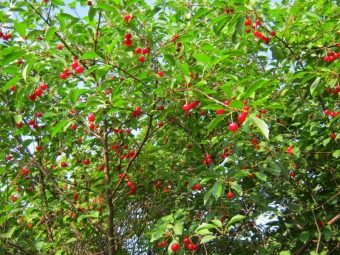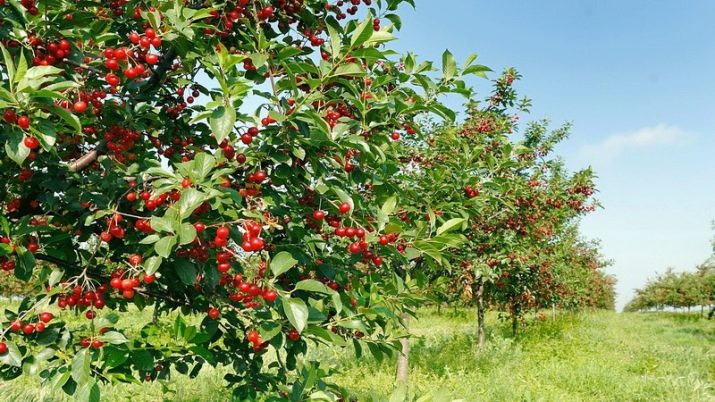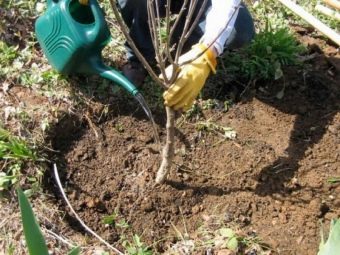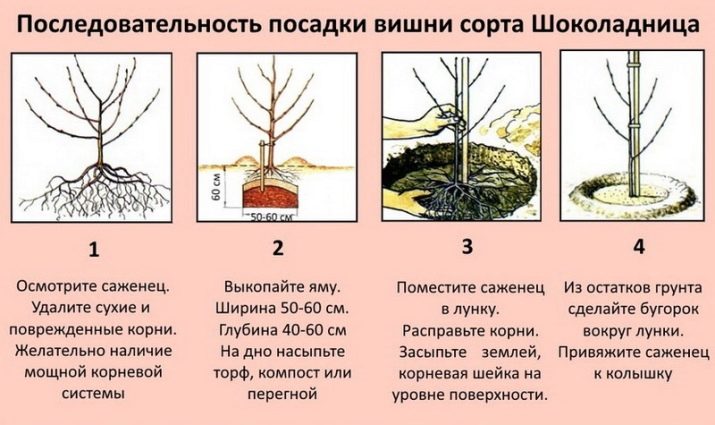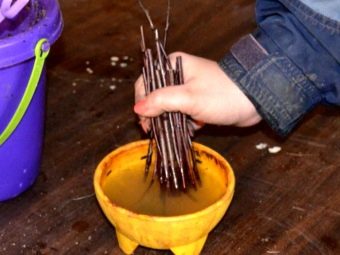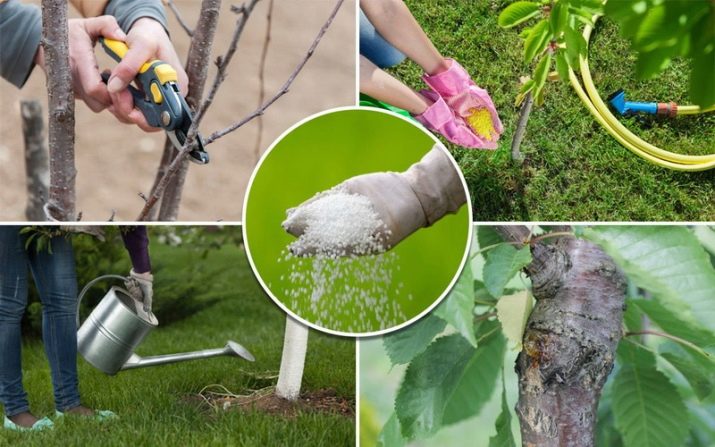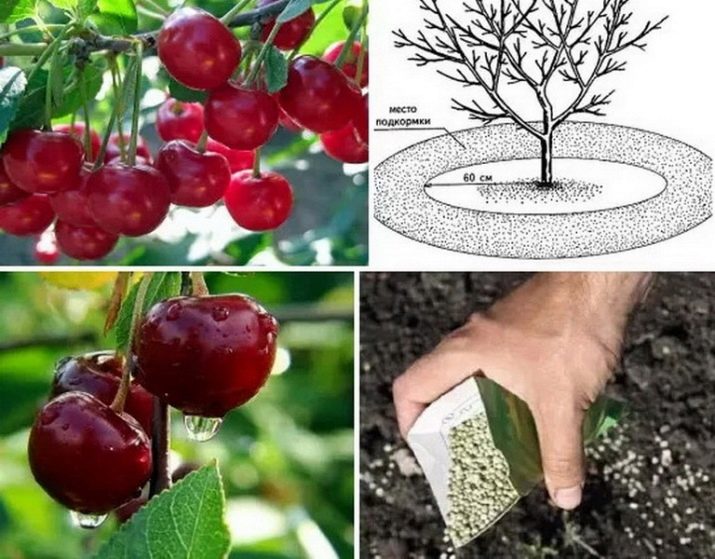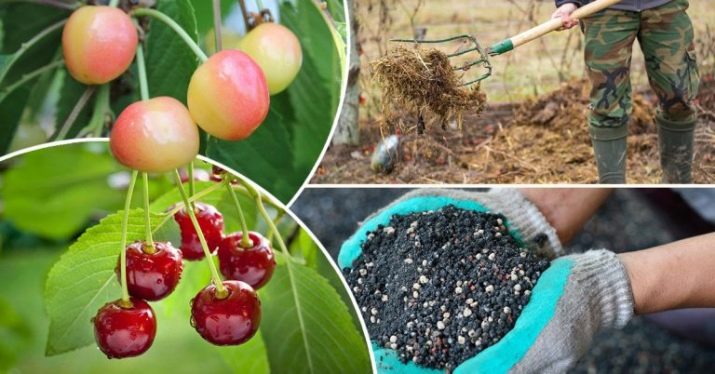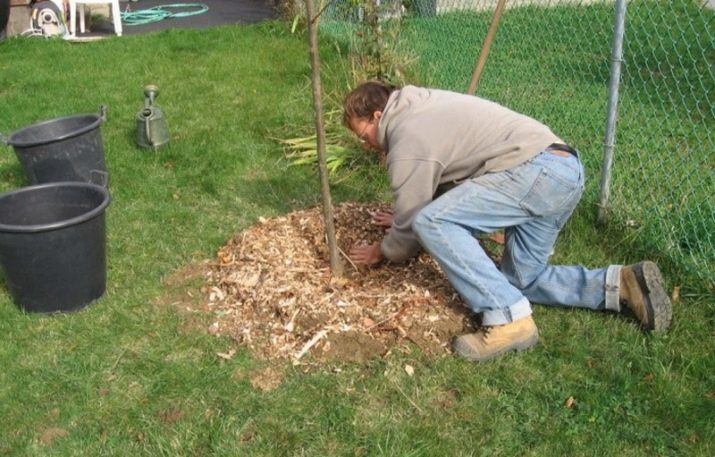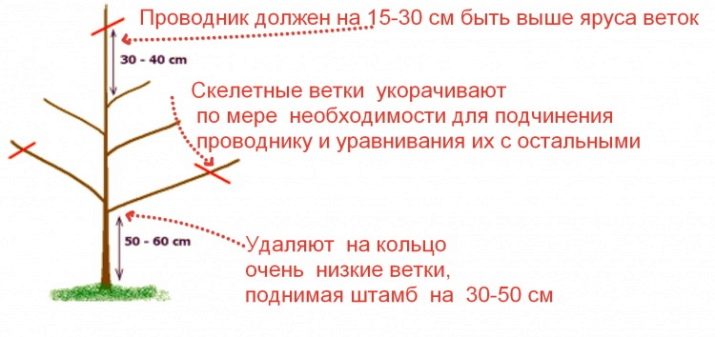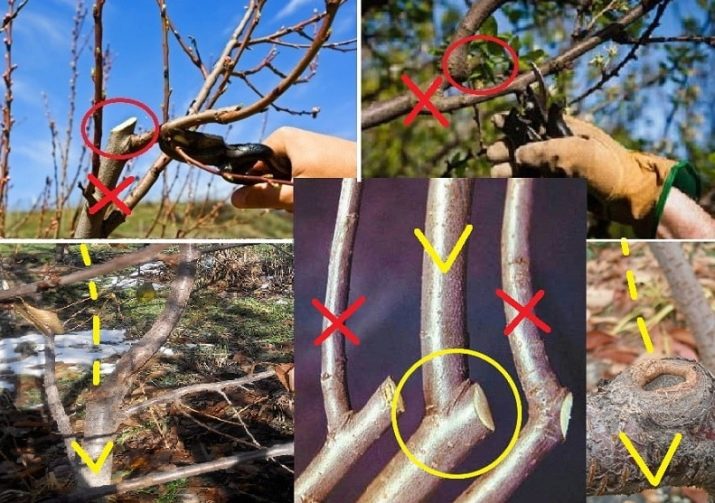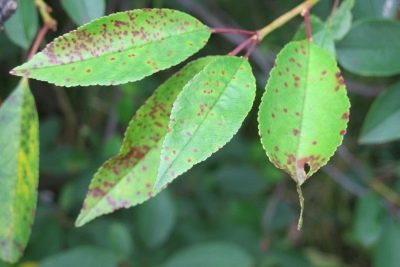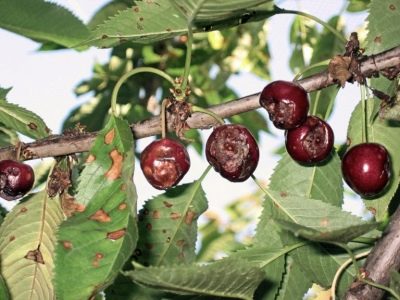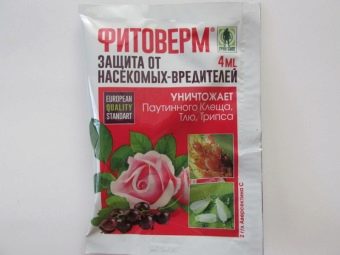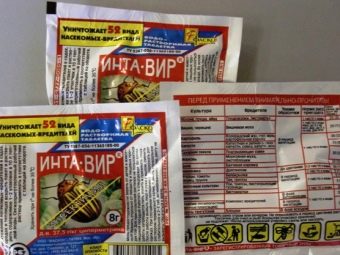Description and cultivation varieties of chocolate "Chocolate"
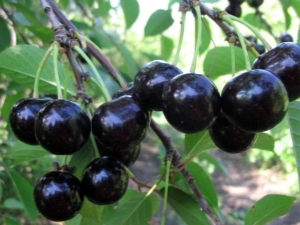
Cherry is able to please even the most sophisticated gardeners. But in order to get a brilliant result, it is necessary to carefully study the characteristics of each particular variety.This fully applies to the "Chocolate" variety.
Description
Cherry is a culture demanded almost all over the world. Widely spreading krone can give a significant amount of fruit. As a result, even a large family will receive a sufficiently large amount of berries to feast on them. There are many varieties of cherries, differing in:
- preferred climatic region;
- growth rate;
- disease susceptibility;
- the size of the harvest.
Cherry "Chocolate" - the result of relatively recent breeding developments. But even in such a short time, this plant has managed to become popular among gardeners. Dense bright coloring of fruits, fast growth, small height and almost zero risk of diseases like many farmers. According to the All-Russian Agronomical Register, This variety is acclimatized for the central part of the country. Breeders, taking up the creation of a new type of fruit culture, maximally developed resistance to cold and growth restriction.
The characteristics of the tree allow it to carry even the most frosty winters in the recommended area. And positive reviews of summer residents note that it is possible to pick berries without ladders or other devices. Even in relatively warm Central Russia, spring frosts are a real test for any garden. “After chocolate” after strong cold weather, it confidently retains both its productivity and attractive appearance. As an experimental material, the developers took the "Black" and "Lubskaya" cherries, which have already proved themselves from the best side.
Cherry "Chocolate" raises its pyramid inverted crown to 2.5 m above the ground. The foliage of the plant looks elegant, it is painted in a thick green tone, but without any shine. Inflorescences of the same type - each with three white flowers. If farmers take care of plantings and thoroughly care for them, the life of a tree can last up to 20 years. Round berries can reach 2 cm in diameter, while their weight is sometimes 3.5 g.
The flesh of the fruit is tender and juicy, the taste is intermediate between sour and sweet. The concentration of useful components is as follows:
- Vitamin P - 1064 mg;
- anthocyanins - 395 mg;
- catechins - 378 mg;
- Vitamin C - 16.7 mg.
For the "Chocolate Girl" pollinators are not particularly needed, and every year it bears fruit at a high level. The tree may be affected by the causative agents of moniliosis and coccomycosis. But if the care of plantings meets agrotechnical standards, the likelihood of disease is negligible. Some farmers believe that it is worth planting other varieties of cherries around “Shokoladnitsa”, first of all these are varieties such as “Flask”, “Turgenevka”, “Lyubskaya”.
Landing
The place in which to plant the “Chocolate” tree is selected very carefully and scrupulously. According to the recommendations of agronomists, the best position would be the soil neutral or weak acid reaction. In addition to the level of acidity, nutrient saturation and drainage quality are important. Excessive moisture can prevent rooting of the tree. Since the plant is light-loving, shaded places are contraindicated.
As evidenced by the experience of growing chocolate "Chocolate", in the shadows she is able to take root. But this way you can get only a meager harvest. In addition to resistance to cold, the plant is able to survive a rather severe drought.
However, the lack of water also adversely affect the number of fruits. That is why it is worth paying heightened attention to the growing conditions.
Planting cherry is made both in spring and in the autumn months. More specific recommendations indicate that April and September are preferred. Farmers with experience say that working in the spring is much more correct when there is less danger of untimely cold weather. A stake is driven into the ground, and a line is drawn around it, the diameter of which corresponds to the borders of the notch. The usual dimensions of the pit are 0.6 m in depth and 0.8 m in width.Extracted land should be mixed with ash or humus, then it is poured into the lower part of the pit.
As soon as this work has been done, a sapling is placed in a pit and its roots are straightened. Immediately, you should cover these roots with soil and water with settled water; the neck of the root should be 30-40 mm above the ground. For your information: the faded top of the seedling can be cut, but only a maximum of 1/3. The space around the trunk sprinkled with sawdust in combination with humus. The soil around the roots needs to be slightly compacted, then the trunk is tied to a stake.
It is possible to propagate cherries both by cuttings and by grafting method. If you plan to use grafting, take a box with a depth of 0.1 m, length 0.25, and a width of 0.5 m. This capacity must be filled with a combination of sand and peat. They are taken exactly the same amount, while it is allowed to change peat to black soil. Pre-mix the mixture moistened with a highly dilute solution of potassium permanganate, and then with clean water.
The amount of added water should be carefully monitored. Excessive accumulation provokes its rotting cuttings. Harvesting planting material is produced when the shoots develop intensively and powerfully. For cuttings, only the green parts of the plant that are thoroughly overgrown and directed upward are suitable. Cut cuttings are sprayed with water, and since the top of the shoot does not root well enough, it is better to remove it immediately.
The recommended length of the cut-off shoot is 0.1 m. According to professionals, the upper cut should be done over the kidney, and the lower cut just below it. Having procured cuttings, they are covered with a 20-30 mm soil mixture, leaving a gap of 60-80 mm. After that, you need to cover the box with polyethylene so that the high humidity helps the plant to take root. For your information: cherry cuttings suffer greatly from direct sunlight, but the overall illumination should be at a decent level.
As soon as the roots appear, the film starts to be removed from time to time. They systematically do this for an ever greater period in order to fully harden the young shoots and at the same time eliminate the risk of their damage. When winter comes, planting material should be prikopat, and the time to land it will come in the spring. Another option - vaccination - is prepared in the fall, when stones are placed in the ground. At the beginning of spring shoots are thinned, leaving intervals of 0.2 m.
When next autumn comes, the plants need to be fed according to standard technology. Weeding from weeds should be done all year round and immediately before feeding. When spring comes and buds swell, you can plant a cherry cutting. Saplings of 1-3 years of life are recommended for transplantation.
Before planting, absolutely all weeds should be removed from the selected location. Fighting with an excess of them will be easier if you dig the ground in 2 tiers. Eliminate the unjustified acidity of the earth by adding 0.4 kg of dolomite flour per 1 sq. Km. The landing pits should be ready 14 days before disembarkation. Ideally, they are prepared in the fall. In order to eliminate confusion, fertile land and soil going to bedding are laid in different places.
Care
In order for the “Chocolate Chocolate” cherry planted in spring or autumn to give a positive result, it is required to comply with certain norms on its content. So, besides certain varieties of cherries, cherry can also act as a pollinator for it. The distance between the individual trees ranges from 200 to 300 cm. During the year the tree rises to 70 cm. Required:
- introduce fertilizer;
- loosen the soil;
- destroy weeds;
- trim a tree;
- prevent infection by disease, monitor the presence of harmful insects.
Watering trees begins in the flowering period. Water must also be added when the berries ripen. In total, you need to make 30-40 liters of water per cherry. If there is nutrient rich earth, fertilizer should be applied only from the fourth year of life.Since the metabolism of the chocolate "Chocolate" is very active, the consumption of basic substances must be compensated.
Normal development is achieved using organic and mineral products. When autumn comes, simultaneously with digging, 0.07-0.08 kg of potash and 0.2 kg of phosphorus mixtures are introduced. Every 2 or 3 years before digging, humus or compost is applied. And in early spring, 0.06-0.07 kg of nitrogen fertilizers are used. The best options are ammonium nitrate and urea.
Top dressing should be done twice during the growing season. Initially, it is done when flowering ends, and repetition should occur after about 14 days. They take 50 liters of water, dissolve in it 1 kg of ash and 10 kg of cow manure. The composition is required to withstand 4-6 days. When the infusion reaches the desired readiness, 5 liters of liquid are poured under each tree, followed by 30 liters of water.
Sometimes fertilizers are used for fertilizing. 15 g of a mixture of potassium chloride and urea are used per 10 liters of water, 25 g of superphosphate is added to them. The principles of applying the composition are the same as for organic fertilizer. Cherry "Chocolate" requires mandatory pruning, which allows you to:
- improve the shape of the crown;
- increase the fecundity of the tree;
- get rid of the affected branches;
- rejuvenate the trees.
It is necessary to cut the plants twice a year - at the beginning and at the end of the growing season. Such work is carried out from the first years of tree growth. Sometimes even pruned freshly planted cherries are allowed. It is made in the first days of March to prevent the movement of tree sap. First of all, branches growing in the middle portion of the crown are cut to eliminate excessive darkening of the shoots.
Secondarily, the branches that grow in the direction of the main trunk must be destroyed. It is undesirable to leave shoots that are sick or cracked. Pruning can be done throughout the fall. It is strictly worth avoiding cutting after the end of the first vegetative season. Violation of this rule threatens to weaken the branches and the disappearance of immunity to frost.
To ensure that the water is distributed as evenly as possible, it is necessary to apply a drip irrigation method. For this purpose, use the groove in the form of a ring or grooves formed for a certain time. In the last days of October, 60-70 liters of water should be watered with cherries. This will allow to moisten the deep soil layers and protect the plant for the winter. For your information: depending on the meteorological situation, watering during the winter may shift for several days in both directions.
Nitrogen-based fertilizers are used in the form of powdered and granular substances. Preliminary soil is loosened, and fertilizers are applied in the amount of 20-25 g per 1 sq. Km. m. Immediately after feeding you need to water the trees. If a solution is prepared, the reagents are applied in the same volume to 10 liters of water. Agronomists consider manure to be the best fertilizer for cherries, its use is possible in both solid and liquid states.
Infusion of herbs and mullein bred 8 times, and droppings of any birds - 15 times. Be sure that from June 1 to June 10, foliar feeding with urea is carried out, 25-30 g of which is dissolved in 10 liters of water. In the middle of June, it is necessary to feed the cherries under the root with superphosphate and potassium chloride. They take 120 and 70 g, respectively, and then diluted in 16-18 liters of water. If the trees are already adults, the amount of nutrients at this point should be twice as much.
In order not to prepare everything on their own, sometimes they use a complex ready-made composition. When it remains about 14 days to reach the ripeness of the berries, cherries are fed under the root ash extract. 30 g of fertilizer put in 1 liter of boiling water and incubated for 3 or 4 hours. Before digging, use humus or compost 4-5 kg per 1 sq. Km. m. These fertilizers mix 70 g of superphosphate and 25 g of potassium.
The land near the cherries need to systematically loosen 100-150 mm deep. At the very trunk depth of loosening is 80-100 mm. This procedure is resorted to after each watering, as well as in the formation of serious crusts.An additional measure of care after watering is the use of sawdust or peat as mulch. For the first 5 years of growth of a cherry circle around the trunk and aisle should remain clean. But on the sixth year and later, to improve the aesthetic characteristics of the garden, planting is recommended:
- various vegetables;
- honey plants;
- herbaceous plants;
- strawberries and some other berry crops.
Speaking about the aesthetic parameters of the chocolate "Chocolate", it is worth mentioning about how best to pruning. Putting shtamb required for the second year after disembarkation. For this purpose, the branches are removed below 250-400 mm. To form a skeleton, use the strongest and correctly placed branches. The angle of departure from the trunk should not be too sharp, while all branches are shortened to an identical level.
An indispensable requirement is the subordination of the branches, both among themselves and in relation to the core conductor. Important: too active pruning does more harm than good. In young plants, it can even postpone the onset of fruiting. The main branches are shortened only for very serious reasons. But even in this case, they can be cut off a maximum of 1/7 of the magnitude of the increase for the year.
When the crown of the cherry itself is naturally folded, it is required to limit the removal of the branches that are poorly located and excessively thicken the crown. Cutting off the branches from young plants is necessary not with the help of a secateur, but with the use of a pointed garden knife. If you cut the branch on the kidney, you can accelerate the tightening of wounds. What you can not do, in principle, is to leave any spikes at work.
If you have to make oblique cuts, you need to follow the coincidence of the end of the incision and the upper line of the kidney. Pruning in early spring is much more attractive than in the fall, because it gives less risk of tree death. It is categorically unacceptable to make an incision if the air temperature is less than 5 degrees below zero.
Diseases and pests
The main diseases of "Chocolate Girl" are associated with a fungal infection. On infection with coccomycosis, you can talk on small purple spots. Turning infected leaves, it is easy to notice clusters of spores, which are painted in pink tone. Foliage falls to the ground too soon. As a result, cold is tolerated too poorly, and if treatment is not carried out, the tree will often die the next year.
The presence of a spore may be on the surface of the berries. Cherries, which are affected by the disease, give poor-quality harvest. Eating fruit is impossible. You can guess the disease by moniliosis by the appearance of the tree. It seems to be singed by a flame, and at first the bark and branches are covered with gray spots like moss.
Further development of the disease leads to the emergence of such sites and on the berries. When the treatment is not carried out, the branches dry up, and the berries are lost (die). The fight against coccomycosis is carried out at the expense of Bordeaux liquid (use a solution of 3%), the composition is used when the next leaves appear. Before flowering, the plants are treated with Skoro, and when the flowers disappear, weak copper oxychloride is used. Which of these formulations to use in the autumn months depends on personal preferences.
A sick moniliose cherry can also be cured, but first you have to remove any affected branch and even a single berry. It is worth remembering that the nests of the fungus often appear under the externally preserved areas of the bark. Leaving even a minor focus, you can soon encounter another bout of illness. It is possible to exclude such a development of events, if you shoot together with obviously infected branches 100-150 mm of a healthy surface.
Prevention of moniliasis involves treatment before flowering. Suitable as a protective agent:
- Bordeaux fluid;
- vitriol based on iron or copper;
- nitrafen;
- Oleocuprit.
Note: Nitrafen should be used only as a last resort, when there are no other drugs and you cannot get them quickly.This remedy is too toxic and therefore its use is limited in some countries. Among the improvised compositions, lime is recommended, which is lubricated every 6 months with both the stumps and the soil near the trees.
If the cherry is covered with cracks, they should be opened, cleaned, and then smeared with garden pitch; rational feeding is very important after that.
Of the pests of particular danger is the slimy sawfly, which looks like a leech. A small number of insects is suppressed by drinking soda or salt, 150 g of which is dissolved in 5 liters of cold water. But with the defeat of 1/10 of the foliage and with more active aggression, we need already specialized drugs - Kemifos and Fufanon. When a leaf aphid appears, it is practiced to use infusion of tobacco boiled for 2 hours, with the addition of soap shavings.
From firm means against aphids help "Fitoverm" and "Inta-Vir". To avoid the attacks of the cherry fly, it is required to carefully dig the ground in the fall. But the fight against infection, if it does happen, requires the use of "Karate" or "Inta-Vira." The recommended time for processing is from May 15 to June 10.
Collection and storage
The maturity of "Chocolate Girl", if all the requirements of agricultural engineering are met and various diseases are prevented, should occur by mid-July. Harvesting, which is planned to be transported far, begins 6-7 days before full maturity. Berries that need to be conserved are removed 2-3 days later. Eat immediately possible only fully ripe fruit.
In order to preserve the harvest, it is torn down along with the petioles, excluding the deformation of both the berry itself and wood. The best option is to cut the stem 2/3 in length with sharp scissors. It is recommended to accumulate cherries for winter in baskets or buckets. Lay it out carefully, making sure that no berry was pierced by the stalks.
Freshly preserved fruits can be a maximum of 5-7 days, and after freezing - up to 18 months.
Description of the characteristics of cherries "Chocolate" look in the next video.



